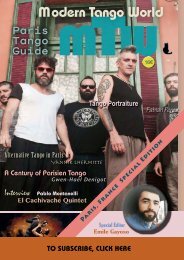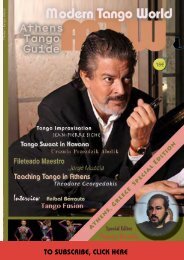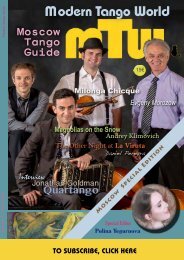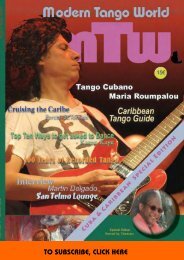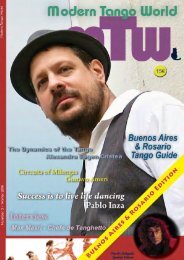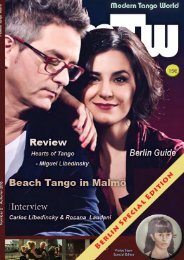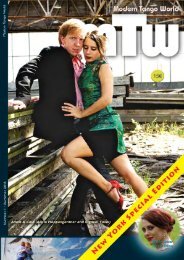Modern Tango World #5 (Mexico)
Mexico Special Features Milongas in the Park Roberto González 3 Snapshot of the Mexican Music Scene Miguel Garcia 6 A New Generation Mauricio Salvador 12 Guide to Tango in Mexico 16 Visual Tango Poems Murat Erdemsel 22 Interview with Plaza Francia Marco Buso 26 Tango Therapy Around the World 30 Movie Review: Tango Pasion Alexandru Eugen Cristea 33 New Tango Music Arndt Büssing 34 Horacio Salgan: Tango Giant 38 DJ/VJ-ing - A VJ Manifesto Zarah Cabanas 40 Tango Moves: caminando Raymond Lauzzana 44 Letters to the Editor 47
Mexico Special Features
Milongas in the Park Roberto González 3
Snapshot of the Mexican Music Scene Miguel Garcia 6
A New Generation Mauricio Salvador 12
Guide to Tango in Mexico 16
Visual Tango Poems Murat Erdemsel 22
Interview with Plaza Francia Marco Buso 26
Tango Therapy Around the World 30
Movie Review: Tango Pasion Alexandru Eugen Cristea 33
New Tango Music Arndt Büssing 34
Horacio Salgan: Tango Giant 38
DJ/VJ-ing - A VJ Manifesto Zarah Cabanas 40
Tango Moves: caminando Raymond Lauzzana 44
Letters to the Editor 47
Create successful ePaper yourself
Turn your PDF publications into a flip-book with our unique Google optimized e-Paper software.
Salgán has won numerous awards, including the<br />
Shining Konex in 2005 as the best musician of the<br />
decade. He retired from the stage in 2003. But, he<br />
would often repeat that he had retired from public<br />
life, but not music. He gave a concert in 2010, during<br />
the celebrations for the bicentennial of the May<br />
Revolution of 1810 that gave Argentina its independence.<br />
https://www.youtube.com/watch?v=KwX4lbJEE34<br />
Salgán helped broaden the musical vocabulary of<br />
the tango and became one of its most influential<br />
and revered maestros. Like his contemporary Astor<br />
Piazzolla, Salgán cast a mesmerizing avantgarde<br />
spell over the tango that did not always enchant<br />
the tango purists that were bound to what<br />
they referred to as traditional tango.<br />
The tango was born on the waterfront, in thr bordellos<br />
by miners and workers in Buenos Aires, during<br />
the 1880s. As it gaines in respectability to become<br />
the Argentina’s signature music, it also became<br />
rigidly formalized. The modernists of the latter half of<br />
the twentieth century challenged this conservatism.<br />
Astor Piazzolla was an outright musical revolutionary<br />
who introduced polyrhythmic and polymelodic<br />
themes, reinventing the tango’s rhythm,<br />
harmony and form. He was lived in France, as an<br />
expatriate and achieved a high level of international<br />
renown that overshadowing Salgán’.<br />
Nevertheless, Horacio Salgán remained a most<br />
important musical force in Argentina, helping to<br />
forge the vanguard of the <strong>Tango</strong> Nuevo sound in the<br />
1950s and 1960s. As he shifted to composing, Salgán<br />
called upon his grounding in the classics as well<br />
as his mulatto heritage, Catalan on his father’s side,<br />
mixed race on his mother’s. In a way, he was less<br />
about rebellion and more about synthesizing some<br />
varied, somewhat un or tho dox musical influences.<br />
Among others, Salgán drew inspiration from the<br />
jazz music of Tommy Dorsey and Duke Ellington,<br />
the classical works by Béla Bartók and Gioachino<br />
Rossini, Brazilian choros and sambas, and<br />
African percussive rhythms. The result was too uncommercial<br />
for the radio. This led to his bandleading<br />
career during tango’s golden age of the 1940s.<br />
In a duo with guitar virtuoso Ubaldo de Lío, this began<br />
a dazzling new phase in Salgán’s career. Liberated<br />
from the need to please the traditional dancers, he<br />
crafted sophisticated instrumentals designed with listeners<br />
in mind and achieved a brilliant balance between<br />
tradition and innovation, as music scholars Kacey Link<br />
and Kristin Wendland put it in their book, Tracing<br />
Tangueros. Salgán toyed with counter melodies and<br />
rhythms, and expressively colored his arrangements<br />
with lines for viola, cello and bass clarinet, instruments<br />
seldom found in traditional tango. But his best-known<br />
compositions isuch as A Fuego Lento,Don Agustin Bardi<br />
and Grillito, remain exquisite, swooning, and melodical.<br />
In addition to writing hundreds of his own compositions,<br />
Salgán also arranged many older tango standards<br />
to suit his more protean tastes. Salgán found<br />
appreciative audiences in world capitals such as New<br />
York, Tokyo and Paris. He survived the fickleness of<br />
musical tastes in his home country. By his 1980s, he<br />
had outlived most of his peers and was revered in<br />
Buenos Aires as tango’s elder statesman.<br />
We are only now understanding just how important<br />
Salgán’s place in tango is, ... His hands did<br />
not tickle the piano, no, no. He is a man who<br />
plays with great authority. And we don’t know<br />
how much longer we’ll have him with us, so this<br />
is the time to hang on to his every note<br />
— Daniel Barenboim<br />
Daniel Barenboim and the Venezuelan conductor<br />
Gustavo Dudamel aew ardent admirers of Salgán’s<br />
music and led symphonic tributes to his tangos. The<br />
celebrated French pianist Jean-Yves Thibaudet<br />
once called Salgán probably the only great tango pianist<br />
alive. Thibaudet pursue recording and touring dates<br />
with Salgán, but the composer had grown too infirm.<br />
Salgán’s music has continued to influence a new generation<br />
of tango artists and composers, among them<br />
Sonia Possetti and Juan Pablo Navarro.<br />
Training in Western symphonic music opened up<br />
a whole world of harmony, orchestration and pianistic<br />
execution, But there’s also a black dimension<br />
to my music. It’s not casual, nor flagrant, but<br />
part of my origin . . . my style and my truth.<br />
— Horacio Salgán<br />
Salgán and de Lio later played with the Quinteto<br />
Real on Saturday nights at the Club del Vino in<br />
Buenos Aires. The formation of Quinteto Real in<br />
1960 led to a five decade collaboration.<br />
— 39 —




